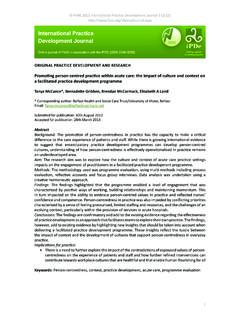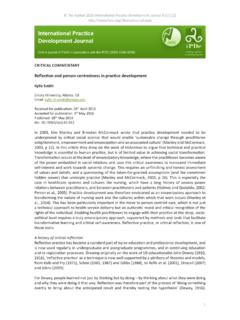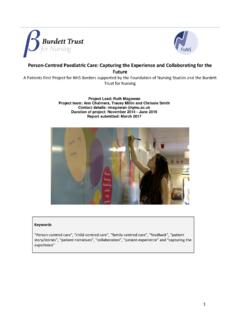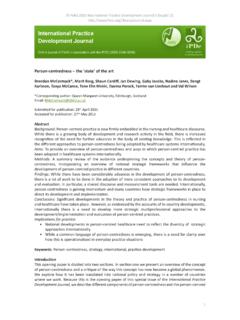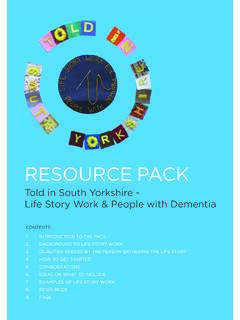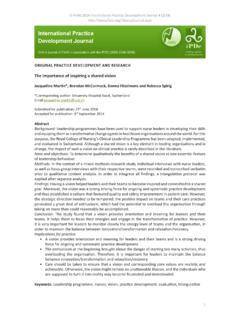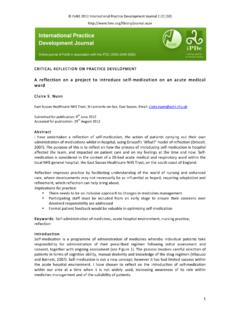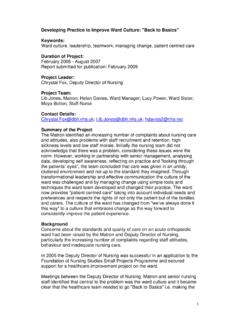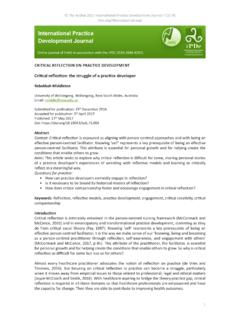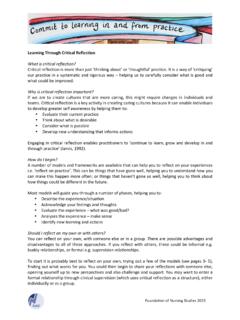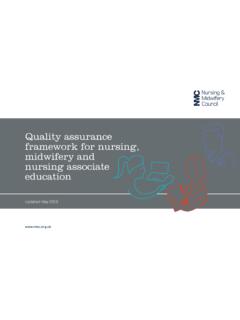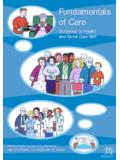Transcription of Concepts of person-centred care: a framework analysis of ...
1 The Authors 2016 International Practice Development Journal 6 (2) [6] PRACTICE DEVELOPMENT AND RESEARCHC oncepts of person- centred care : a framework analysis of five studies in daily care practicesMargreet van der Cingel*, Lobke Brandsma, Mirjam van Dam, Marcella van Dorst, Claudia Verkaart and Cilleke van der Velde*Corresponding author: Windesheim University of Applied Sciences, Zwolle, NetherlandsEmail: for publication: 21st July 2016 Accepted for publication: 28th October 2016 Published: 16th November 2016 : Person- centred care is used as a term to indicate a made to measure approach in care . But what does this look like in daily practice? The person- centred nursing framework developed by McCormack and McCance (2010) offers specific Concepts but these are still described in rather general terms. Empirical studies, therefore, could help to clarify them and make person-centredness more tangible for nurses.
2 Aims: This paper describes how a framework analysis aimed to clarify the Concepts described in the model of McCormack and McCance in order to guide professionals using them in : Five separate empirical studies focusing on older adults in the Netherlands were used in the framework analysis . The research question was: How are Concepts of person- centred care made tangible where empirical data are used to describe them? analysis was done in five steps, leading to a comparison between the description of the Concepts and the empirical significance found in the studies. Findings: Suitable illustrations were found for the majority of Concepts . The results show that an empirically derived specification emerges from the data. In the concept of caring relationship for example, it is shown that the personal character of each relationship is expressed by what the nurse and the older person know about each other.
3 Other findings show the importance of values being present in care practices. Conclusions: The framework analysis shows that Concepts can be clarified when empirical studies are used to make person- centred care tangible so nurses can understand and apply it in practice. Implications for practice:The Concepts of the person- centred nursing framework are recognised when: Nurses know unique characteristics of the person they care for and what is important to them,and act accordingly Nurses use values such as trust, involvement and humour in their care practice Acknowledgement of emotions and compassion create mutuality in the caring relationshipKeywords: Person- centred care , framework analysis , concept clarification, empirical studies, value-based care , professional nurse behaviourworking together to develop practiceOnline journal of FoNS in association with the IPDC (ISSN 2046-9292) The Authors 2016 International Practice Development Journal 6 (1) [6] care is a relatively new but emerging phenomenon today.
4 It covers a variety of views, theories and conceptual models (McCormack et al., 2015). However, despite this increasing interest, there is a lack of clarity among healthcare professionals about what person- centred care is and how it is to be practised (Morgan and Yoder, 2012). There s a risk that the concept will end up in the same position as the concept of patient- centred care in the last decades of the 20th century, that is to say as fashionable but not practice-driven terminology. The person- centred nursing framework of McCormack and McCance (2010) offers a theoretical model with descriptions of core Concepts and their mutual relations. Besides being a framework that offers building blocks for the realisation of good care , the framework is interwoven with a strategy known as transformational practice development and research methodologies that originate from the action research paradigm (McCormack and McCance, 2016).
5 The framework therefore is particularly suitable for empirical studies that aim to develop practical knowledge on the realisation of person- centred care . In addition, the framework was chosen as the theoretical foundation to explore in the research programme since it fitted so well with the mission statement of the university s research group for innovation in care of older adults, in which patient empowerment and participation is central. A lot of research has already been done on the development and clarification of the Concepts of the framework (McCormack et al., 2015). Yet, empirical studies that try to underpin the Concepts of person- centred care seem to be less available, at least among research conducted in the Netherlands. In daily practice, nurses and care organisations express a clear need for hands-on knowledge of person- centred care . They wish to know how to practice person- centred care in more detail and, alongside obstacles such as time-pressure and workload, they mention an inability to express person-centredness.
6 The question arises: what are implications for the behaviour of nurses and their interaction with patients or residents? There is also a need for further clarification of the Concepts for educational purposes, to translate them into concrete knowledge, skills and attitude. This is necessary if person- centred care is to be recognised in competency descriptions for nursing and nurse educational programmes such as the Canmeds (Canadian Medical Education Directives for Specialists, 2015) competency framework . Therefore the research group s researchers started a research programme in 2013 on person- centred care , with the specific aim to gain knowledge on the empirical underpinning of its Concepts . In recent years, several studies have been performed by masters students in nursing sciences under the supervision of the research group. Although they varied in their main research topic, questions and methods, all these studies were theoretically founded on the person- centred nursing framework of McCormack and McCance (2010).
7 The feeling emerged from five of these studies that there was an overall result to be found, besides the valuable findings of each separate study. Such an overall result would infuse the Concepts inductively. For this reason a framework analysis was aim of the framework analysis was concept clarification from an inductive perspective of several stakeholders, such as people who need care , their informal carers and nurses and nurse assistants. The overall study specifically aimed to underpin the person- centred care Concepts by means of seeking and categorising citations that would fit the theoretical description. The ultimate goal was to give concrete and practice-driven examples to give nurses input into person- centred behaviour. Method When five separate studies on person- centred care (see Table 1) were completed, the research team, which included all this study s authors, decided to address the search for empirical findings in support of the theoretical Concepts of the framework .
8 The research question was: How are person- centred care Concepts made tangible where empirical data is used to describe them? The additional framework analysis was the chosen method because it offers a flexible but systematic and rigorous way to analyse existing data in a secondary analysis . The framework analysis consisted of five steps derived from Ward et al. (2013) and Ritchie et al. (2003). The Authors 2016 International Practice Development Journal 6 (1) [6] The findings of each study were classified into the Concepts of the framework of McCormack and McCance (2010) by the research team. For this, a translated version of the framework adapted for the Netherlands was used (see Table 2). Translation was kept as close as possible to the original, but adaptation was necessary for better semantic understanding and the use of language in Dutch care contexts. The classification of findings of each study was then screened for face validity by the researcher of each of the individual studies.
9 2. Researchers of the individual studies then re-read their data in a secondary deductive coding of relevant quotations, using the descriptions of the Concepts and categories as branches of a coding tree (which represents all codes that were assigned to quotations).3. All relevant quotations of each study were positioned into a schedule separately, a framework according to the coding tree of Concepts . Subsequently, three external researchers independently performed an analysis of the schedule in order to gain face validity. 4. Their analysis , remarks and argumentation for correct or incorrect placing of quotations into the classification was then discussed by the group of researchers from the original studies. The group was divided into two and each discussed the complete framework again and weighed the analysis and remarks of the external researchers. All quotations that prompted discussion in either group were set aside for further debate by the group of researchers as a whole until consensus was reached or a decision to remove the quotation from the framework was made.
10 5. Finally, the frameworks of classified quotations of each study was merged into a single framework in which all quotations were classified together into the Concepts and preliminary conclusions were drawn. If conclusions could not be made, hypotheses were formed. This was first done by the senior researcher (first author) and then presented to the research group for final categorisation. Findings Five studies on person- centred careThe research group at Windesheim is one of the partners of the faculty of nursing science at the University of Utrecht in the Netherlands, which provides traineeships for masters students. The research group describes a broad outline for research projects from which students can make their choice. This outline has a few guidelines: projects need to fit within the aim of a research programme; and studies performed should predominantly have a qualitative or at least a mixed-methods character.
